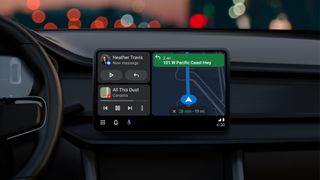One of my major Android Auto frustrations is finally getting fixed
New Android Auto updates revealed at Google IO 2022

There's good news for Android Auto users, as updates for the in-car, phone-mirroring system announced during Google IO 2022 have revealed a new-look UI and better functionality.
And it's about time.
Google made a number of Android Automotive OS and Android Auto update announcements on Thursday, and the one which really caught my attention was the new UI for the later system, which allows the interface to seamless scale to any screen-size in your car - as shown by the GIF above.
It means those using Android Auto - where you connect your smartphone to your vehicle's display either wirelessly or via a USB cable - will see the system take full advantage of the space available. Something it doesn't do currently.
Years of frustration
Look, I love Android Auto. It's helped me navigate roads not only in my native England, but across Europe and North America for years.
Google's clear navigation and real-time traffic makes driving abroad so much simpler, while integrations with Spotify and WhatsApp keep me entertained and in-touch.
It's not a perfect system, and I'm constantly frustrated whenever I link Android Auto in a new car and it uses only part of the screen available, often leaving a chunk of display redundant.
Get daily insight, inspiration and deals in your inbox
Get the hottest deals available in your inbox plus news, reviews, opinion, analysis and more from the TechRadar team.
With the advancements of in-car tech, expedited by the uptick in electric vehicles (EVs) which are boasting ever increasing screen sizes, there's an awful lot of real estate to play with, and Auto is finally about to take advantage.
Even in my personal car, a Kia Niro, I'm looking forward to Android Auto filling the entirety of the central display as currently it fills roughly two thirds, leaving the final third unused.

The ability for Auto to intelligently scale to whatever screen size and orientation it's being shown on will allow it to display more app functions at once, reducing the distraction of having to switch between them, while also providing larger, clearer visuals.
The new UI will prioritize "core user needs", which means alongside mapping, you'll also see your other commonly used applications such as podcasts, music and audiobooks.
Once the update rolls out, Android Auto will also share relevant, contextual alerts and suggestions, such as the option to share your arrival time with others and reply to messages or missed calls with a single tap.
This Android Auto update won't solve everyone's bug-bears, but it's a huge positive step in the right direction for me.
Google says the update will roll out globally "just in time for summer", which means it should be imminent (May / June 2022).
We contacted the search giant to ask for further clarification on this, but a spokesperson was unable to give us a firm date for the update to drop.
Automotive OS gets video boost
It's not just Android Auto that's getting new skills though, as Google also announced new video apps for its Android Automotive OS.
The Automotive OS is baked directly into vehicles and does not require your smartphone, giving you direct access to key Google apps and many more via the Play Store, all on the screen in the car.
The pool of vehicles which currently run Android Automotive OS is still relatively small, but GM, Ford, Nissan, Volvo, Polestar, Honda and Renault currently offer it in select models.
And soon (no exact date yet), you'll be able to watch video on a trio of new apps which are being added to the platform; Tubi, YouTube and Epix. They'll only be available when you're parked up - whether that's while you charge your EV, or wait on a curbside pickup.
A little further down the line (again, no firm date yet), you'll also be able to browse the web from the comfort of your car - when parked. These are features we've already seen in Teslas, but with Google bringing them to its in-car OS, it means more drivers in the future will gain access.

John joined TechRadar over a decade ago as Staff Writer for Phones, and over the years has built up a vast knowledge of the tech industry. He's interviewed CEOs from some of the world's biggest tech firms, visited their HQs and has appeared on live TV and radio, including Sky News, BBC News, BBC World News, Al Jazeera, LBC and BBC Radio 4. Originally specializing in phones, tablets and wearables, John is now TechRadar's resident automotive expert, reviewing the latest and greatest EVs and PHEVs on the market. John also looks after the day-to-day running of the site.

Amazon just dropped one of this year's best tablet deals – and it's not the iPad

Microsoft pinches one of the best macOS features for Windows 11 – here are three other ideas it should steal from Apple

Could generative AI save small businesses $4000 in 2024? We talk to GoDaddy about its most recent survey.